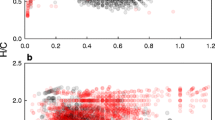Abstract
Electrospray ionization mass spectrometry (ESI-MS) was used to evaluate the average molecular mass of terrestrial humic substances, such as humic (HA) and fulvic (FA) acids from a soil, and humic acid from a lignite (NDL). Their ESI mass spectra, by direct infusion, gave average molecular masses comparable to those previously obtained for aquatic humic materials. The soil HA and FA were further separated in size-fractions by preparative high performance size exclusion chromatography (HPSEC) and analyzed with ESI-MS by both direct infusion and a further on-line analytical HPSEC. Unexpectedly, their average molecular mass was only slightly less than for the bulk sample and, despite different nominal molecular size, did not substantially vary among size-fractions. The values increased significantly (up to around 1200 Da) after on-line analytical HPSEC for the HA bulk sample, at both pH 8 and 4, and for the HA size-fractions when pH was reduced from 8 to 4. It was noticed that HA size-fractions at pH 8 were separated by on-line HPSEC in further peaks showing average masses which progressively increased with elution volume. Furthermore, when the HA and NDL bulk samples were sequentially ultracentrifuged at increasing rotational speed, their supernatants showed mass values which were larger than bulk samples and increased with rotational speed. These variations in mass values indicate that the electrospray ionization is dependent on the composition of the humic molecular mixtures and increases when their heterogeneity is progressively reduced. It is suggested that the dominance of hydrophobic compounds in humic supramolecular associations may inhibit the electrospray ionization of hydrophilic components. Our results show that ESI-MS is reasonably applicable to humic substances only after an extensive reduction of their chemical complexity.









Similar content being viewed by others
References
Hayes MHB, MacCarthy P, Malcolm RL, Swift RS (eds) (1989) Humic substances II. In search of structure. Wiley, New York, pp4–31
Piccolo A (ed) (1996) Humic substances in terrestrial ecosystems. Elsevier, Amsterdam, pp225–264
Stevenson FJ, Cole MA (1999) The cycles of soils, 2nd edn. Wiley, New York
Hayes MHB, Clapp CE (2001) Soil Sci 166:723
Piccolo A (2002) Adv Agron 75:57
Ghosh K, Schnitzer M (1980) Soil Sci 129:266
Wershaw RL (1993) Environ Sci Technol 27:814
Engebretson RR, von Wandruszka R (1994) Environ Sci Technol 28:1934
Stevenson FJ (1994) Humus chemistry. Genesis, composition, and reaction, 2nd edn. Wiley, New York
Conte P, Piccolo A (1999) Environ Sci Technol 33:1682
Piccolo A, Conte P, Trivellone E, Van Lagen B, Buurman P (2002) Environ Sci Technol 36:76
Piccolo A, Conte P (2000) Adv Environ Res 3:508
Hayes MHB, Wilson WS (eds) (1997) Humic substances, peats and sludges. RSC, Cambridge, pp39–45
Simpson AJ, Kingery WL, Shaw DR, Spraul M, Humpfer E, Dvortsak P (2001) Environ Sci Technol 35:3321
Simpson AJ, Kingery WL, Shaw DR, Spraul M, Humpfer E, Dvortsak P, Kerssebaum R, Godejohann M, Hofmann M (2002) Naturwissenschaften 89:84
Simpson AJ (2002) Magn Reson Chem 40:S72
Buurman P, van Lagen B, Piccolo A (2002) Org Geochem 33:367
McIntyre C, Batts BD, Jardine DR (1997) J Mass Spectrom 32:328
Klaus U, Pfeiffer T, Spiteller M (2000) Environ Sci Technol 34:3514
Ikeda K, Arimura R, Echigo S, Shimizu Y, Minear RA, Matsui S (2000) Water Sci Technol 42:383
Persson L, Alsberg T, Kiss G, Odham G (2000) Rapid Commun Mass Spectrom 14: 286
Moulin V, Reiller P, Amekraz B, Moulin C (2001) Rapid Commun Mass Spectrom 15: 2488
Pfeifer T, Uwe K, Hoffmann R, Spiteller M (2001) J Chrom 926:151
McIntyre C, Jardine DR, McRae C (2001) Rapid Commun Mass Spectrom 15:1974
Plancque G, Amekraz B, Moulin V, Toulhat P, Moulin C (2001) Rapid Commun Mass Spectrom 15:827
Leenheer JA, Rostad CE, Gates PM, Furlong ET, Ferrer I (2001) Anal Chem 73: 1461
Cole EB (1997) Electrospray ionization mass spectrometry. Fundamentals, instrumentation and applications. Wiley, New York
Cole EB (2000) J Mass Spectrom 35:763
Fievre A, Solouki T, Marshall AG, Cooper WT (1997) Energy Fuels 11:554
Solouki T, Freitas MA, Alomary A (1999) Anal Chem 71:4719
Brown TL, Rice JA (2000) Anal Chem 72:384
Stenson AC, Landing WM, Marshall AG, Cooper WT (2002) Anal Chem 74:4397
Novotny FJ, Rice JA (1995) Environ Sci Technol 29:2464
De Hoffmann E, Stroobant V (2001) Mass spectrometry. Principles and applications, 2nd edn. Wiley, Chichester, p36
Cozzolino A, Conte P, Piccolo A (2001) Soil Biol Biochem 33:563
Mueller M, Schmitt D, Frimmel F (2000) Environ Sci Technol 34:4867
Cooper AR (ed) (1989) Determination of molecular weight. Wiley, New York, pp1–6
Schwarzenbach RP, Gschwend PM, Imboden DM (1993) Environmental organic chemistry. Wiley, New York, pp82–85
Tanford C (1991) The hydrophobic effect: formation of micelles and biological membranes. Krieger, Malabar, Florida
Acknowledgements
The first author is grateful for the 1999 award received from the Alexander von Humboldt Foundation that supported his research in Germany. The collaboration of Dr. T. Pfeifer, Dr. K.Sielex, and Mrs. S. Richter in ESI analyses is gratefully appreciated.
Author information
Authors and Affiliations
Corresponding author
Rights and permissions
About this article
Cite this article
Piccolo, A., Spiteller, M. Electrospray ionization mass spectrometry of terrestrial humic substances and their size fractions. Anal Bioanal Chem 377, 1047–1059 (2003). https://doi.org/10.1007/s00216-003-2186-5
Received:
Revised:
Accepted:
Published:
Issue Date:
DOI: https://doi.org/10.1007/s00216-003-2186-5




